Impact of Post-Fire Rehabilitation Treatments on Forest Soil Infiltration in Mediterranean Landscapes: A Two-Year Study
Abstract
1. Introduction
- Emergency Soil Stabilization Measures, to be implemented within one year after the fire.
- Rehabilitation Efforts, to support the natural regeneration of the ecosystems, which should be carried out 1–3 years post-fire.
- Restoration Measures, which focus on the total recovery and restoration of ecosystem productivity and resilience and should be implemented over three years after the wildfire.
2. Materials and Methods
2.1. Study Sites
2.2. Experimental Plots
2.3. Infiltration Experiments and Methods
2.4. Soil and Vegetation Density Sampling and Analysis
3. Results
3.1. Meteorological Conditions After the Wildfires
3.2. Changes in Soil Properties and Vegetation Density
3.3. Changes in Infiltration Capacity and Soil Water Conductivity
4. Discussion
5. Conclusions
Author Contributions
Funding
Data Availability Statement
Acknowledgments
Conflicts of Interest
References
- Inbar, M.; Tamir, M.I.; Wittenberg, L. Runoff and erosion processes after a forest fire in Mount Carmel, a Mediterranean area. Geomorphology 1998, 24, 17–33. [Google Scholar] [CrossRef]
- Úbeda, X.; Pereira, P.; Outeiro, L.; Martin, D. Effects of fire temperature on the physical and chemical characteristics of the ash from two plots of cork oak (Quercus suber). Land Degrad. Dev. 2009, 20, 589–608. [Google Scholar] [CrossRef]
- Wittenberg, L.; Malkinson, D.; Beeri, O.; Halutzy, A.; Tesler, N. Spatial and temporal patterns of vegetation recovery following sequences of forest fires in a Mediterranean landscape, Mt. Carmel Israel. Catena 2007, 71, 76–83. [Google Scholar] [CrossRef]
- Francos, M.; Úbeda, X.; Pereira, P. Impact of torrential rainfall and salvage logging on post-wildfire soil properties in NE Iberian Peninsula. Catena 2019, 177, 210–218. [Google Scholar] [CrossRef]
- Proutsos, N.D.; Tsiros, I.X.; Nastos, P.; Tsaousidis, A. A note on some uncertainties associated with Thornthwaite’s aridity index introduced by using different potential evapotranspiration methods. Atmos. Res. 2021, 260, 105727. [Google Scholar] [CrossRef]
- Tsiros, I.X.; Nastos, P.; Proutsos, N.D.; Tsaousidis, A. Variability of the aridity index and related drought parameters in Greece using climatological data over the last century (1900–1997). Atmos. Res. 2020, 240, 104914. [Google Scholar] [CrossRef]
- Stefanidis, S.; Rossiou, D.; Proutsos, N. Drought severity and trends in a Mediterranean oak forest. Hydrology 2023, 10, 167. [Google Scholar] [CrossRef]
- Dimitrakopoulos, A.; Gogi, C.; Stamatelos, G.; Mitsopoulos, I. Statistical analysis of the fire environment of large forest fires (> 1000 ha) in Greece. Pol. J. Environ. Stud. 2011, 20, 327–332. [Google Scholar]
- Fernandez-Anez, N.; Krasovskiy, A.; Müller, M.; Vacik, H.; Baetens, J.; Hukić, E.; Kapovic Solomun, M.; Atanassova, I.; Glushkova, M.; Bogunović, I. Current wildland fire patterns and challenges in Europe: A synthesis of national perspectives. Air Soil Water Res. 2021, 14, 11786221211028185. [Google Scholar] [CrossRef]
- FAO; Plan Bleu. State of Mediterranean Forests 2018; Food and Agriculture Organization of the United Nations, United Nations Environment Programme, Mediterranean Action Plan Barcelona Convention, Plan Bleu: Rome, Italy; Marseille, France, 2018. [Google Scholar]
- Morán-Ordóñez, A.; Duane, A.; Gil-Tena, A.; De Cáceres, M.; Aquilué, N.; Guerra, C.A.; Geijzendorffer, I.R.; Fortin, M.J.; Brotons, L. Future impact of climate extremes in the Mediterranean: Soil erosion projections when fire and extreme rainfall meet. Land Degrad. Dev. 2020, 31, 3040–3054. [Google Scholar] [CrossRef]
- McGuire, L.A.; Youberg, A.M. Impacts of successive wildfire on soil hydraulic properties: Implications for debris flow hazards and system resilience. Earth Surf. Process. Landf. 2019, 44, 2236–2250. [Google Scholar] [CrossRef]
- Shakesby, R.A. Post-wildfire soil erosion in the Mediterranean: Review and future research directions. Earth-Sci. Rev. 2011, 105, 71–100. [Google Scholar] [CrossRef]
- Soulis, K.X.; Generali, K.A.; Papadaki, C.; Theodoropoulos, C.; Psomiadis, E. Hydrological response of natural mediterranean watersheds to forest fires. Hydrology 2021, 8, 15. [Google Scholar] [CrossRef]
- Doerr, S.H.; Thomas, A.D. The role of soil moisture in controlling water repellency: New evidence from forest soils in Portugal. J. Hydrol. 2000, 231, 134–147. [Google Scholar] [CrossRef]
- Jordán, A.; Zavala, L.M.; Mataix-Solera, J.; Doerr, S.H. Soil water repellency: Origin, assessment and geomorphological consequences. Catena 2013, 108, 1–5. [Google Scholar] [CrossRef]
- Francos, M.; Colino-Prieto, F.; Sánchez-García, C. How Mediterranean Ecosystem Deals with Wildfire Impact on Soil Ecosystem Services and Functions: A Review. Land 2024, 13, 407. [Google Scholar] [CrossRef]
- Pereira, P.; Francos, M.; Brevik, E.C.; Ubeda, X.; Bogunovic, I. Post-fire soil management. Curr. Opin. Environ. Sci. Health 2018, 5, 26–32. [Google Scholar] [CrossRef]
- Carmona-Yáñez, M.D.; Francos, M.; Miralles, I.; Soria, R.; Ahangarkolaee, S.S.; Vafaie, E.; Zema, D.A.; Lucas-Borja, M.E. Short-term impacts of wildfire and post-fire mulching on ecosystem multifunctionality in a semi-arid pine forest. For. Ecol. Manag. 2023, 541, 121000. [Google Scholar] [CrossRef]
- Francos, M.; Pereira, P.; Alcañiz, M.; Úbeda, X. Post-wildfire management effects on short-term evolution of soil properties (Catalonia, Spain, SW-Europe). Sci. Total Environ. 2018, 633, 285–292. [Google Scholar] [CrossRef]
- Lucas-Borja, M.E.; Plaza-Álvarez, P.A.; Yáñez, M.D.C.; Miralles, I.; Ortega, R.; Soria, R.; Candel-Pérez, D.; Zema, D.A. Long-term evaluation of soil functionality in Mediterranean forests after a wildfire and post-fire hillslope stabilisation. For. Ecol. Manag. 2024, 555, 121715. [Google Scholar] [CrossRef]
- Robichaud, P.R.; Ashmun, L.E. Tools to aid post-wildfire assessment and erosion-mitigation treatment decisions. Int. J. Wildland Fire 2012, 22, 95–105. [Google Scholar] [CrossRef]
- Robichaud, P.R.; Wagenbrenner, J.W.; Pierson, F.B.; Spaeth, K.E.; Ashmun, L.E.; Moffet, C.A. Infiltration and interrill erosion rates after a wildfire in western Montana, USA. Catena 2016, 142, 77–88. [Google Scholar] [CrossRef]
- Sapountzis, M.; Efthimiou, G.; Stefanidis, P. The contribution of agrotechnical works following a fire to the protection of forest soils and the regeneration of natural forest. In Eco-and Ground Bio-Engineering: The Use of Vegetation to Improve Slope Stability, Proceedings of the First International Conference on Eco-Engineering, Thessaloniki, Greece, 13–17 September 2004; Developments in Plant and Soil Sciences; Springer: Dordrecht, The Netherlands, 2007; pp. 353–359. [Google Scholar]
- Lucas-Borja, M.E.; Fernández, C.; Plaza-Alvarez, P.A.; Zema, D.A. Variability of hydraulic conductivity and water repellency of soils with fire severity in pine forests and reforested areas under Mediterranean conditions. Ecohydrology 2022, 15, e2472. [Google Scholar] [CrossRef]
- Martin, D.A.; Moody, J.A. Comparison of soil infiltration rates in burned and unburned mountainous watersheds. Hydrol. Process. 2001, 15, 2893–2903. [Google Scholar] [CrossRef]
- Valzano, F.; Greene, R.; Murphy, B. Direct effects of stubble burning on soil hydraulic and physical properties in a direct drill tillage system. Soil Tillage Res. 1997, 42, 209–219. [Google Scholar] [CrossRef]
- Cerdà, A. Changes in overland flow and infiltration after a rangeland fire in a Mediterranean scrubland. Hydrol. Process. 1998, 12, 1031–1042. [Google Scholar] [CrossRef]
- Garrido-Ruiz, C.; Sandoval, M.; Stolpe, N.; Sanchez-Hernandez, J.C. Fire impacts on soil and post fire emergency stabilization treatments in Mediterranean-climate regions. Chil. J. Agric. Res. 2022, 82, 335–347. [Google Scholar] [CrossRef]
- Kribeche, H.; Bautista, S.; Gimeno, T.; Blade, C.; Vallejo, V.R. Evaluating the effectiveness of post fire emergency rehabilitation treatments on soil degradation and erosion control in semi-arid mediterranean areas of the Spanish South East. Arid Land Res. Manag. 2013, 27, 361–376. [Google Scholar] [CrossRef]
- Larson-Nash, S.S.; Robichaud, P.R.; Pierson, F.B.; Moffet, C.A.; Williams, C.J.; Spaeth, K.E.; Brown, R.E.; Lewis, S.A. Recovery of small-scale infiltration and erosion after wildfires. J. Hydrol. Hydromech. 2018, 66, 261–270. [Google Scholar] [CrossRef]
- Moody, J.A.; Ebel, B.A.; Nyman, P.; Martin, D.A.; Stoof, C.; McKinley, R. Relations between soil hydraulic properties and burn severity. Int. J. Wildland Fire 2015, 25, 279–293. [Google Scholar] [CrossRef]
- Moody, J.A.; Kinner, D.A.; Úbeda, X. Linking hydraulic properties of fire-affected soils to infiltration and water repellency. J. Hydrol. 2009, 379, 291–303. [Google Scholar] [CrossRef]
- Robichaud, P.R. Measurement of post-fire hillslope erosion to evaluate and model rehabilitation treatment effectiveness and recovery. Int. J. Wildland Fire 2005, 14, 475–485. [Google Scholar] [CrossRef]
- Kennard, D.; Gholz, H. Effects of high-and low-intensity fires on soil properties and plant growth in a Bolivian dry forest. Plant Soil 2001, 234, 119–129. [Google Scholar] [CrossRef]
- Robichaud, P.R. Fire effects on infiltration rates after prescribed fire in Northern Rocky Mountain forests, USA. J. Hydrol. 2000, 231, 220–229. [Google Scholar] [CrossRef]
- Savadogo, P.; Sawadogo, L.; Tiveau, D. Effects of grazing intensity and prescribed fire on soil physical and hydrological properties and pasture yield in the savanna woodlands of Burkina Faso. Agric. Ecosyst. Environ. 2007, 118, 80–92. [Google Scholar] [CrossRef]
- Dilshan, W.; Hiraga, Y.; Kazama, S. Effects of Large Wildfire Burned Scars on Downstream Flood Discharge in California Watersheds: A Hydrological Modeling Study. In Proceedings of the World Environmental and Water Resources Congress 2025, Anchorage, Alaska, 18–21 May 2025; pp. 20–28. [Google Scholar]
- González-Pelayo, O.; Andreu, V.; Gimeno-García, E.; Campo, J.; Rubio, J.L. Effects of fire and vegetation cover on hydrological characteristics of a Mediterranean shrubland soil. Hydrol. Process. Int. J. 2010, 24, 1504–1513. [Google Scholar] [CrossRef]
- Sion, B.; Samburova, V.; Berli, M.; Baish, C.; Bustarde, J.; Houseman, S. Assessment of the effects of the 2021 Caldor megafire on soil physical properties, eastern Sierra Nevada, USA. Fire 2023, 6, 66. [Google Scholar] [CrossRef]
- Oswald, B.P.; Dunson, C.P.; Farrish, K.W. Prescribed Burning under Differing Forest Cover Types and Its Influence on Soil Water Infiltration Rates and Physical Properties in East Texas Forests. Forests 2023, 14, 2083. [Google Scholar] [CrossRef]
- Inbar, A.; Lado, M.; Sternberg, M.; Tenau, H.; Ben-Hur, M. Forest fire effects on soil chemical and physicochemical properties, infiltration, runoff, and erosion in a semiarid Mediterranean region. Geoderma 2014, 221, 131–138. [Google Scholar] [CrossRef]
- Niemeyer, R.J.; Bladon, K.D.; Woodsmith, R.D. Long-term hydrologic recovery after wildfire and post-fire forest management in the interior Pacific Northwest. Hydrol. Process. 2020, 34, 1182–1197. [Google Scholar] [CrossRef]
- Zema, D.A. Postfire management impacts on soil hydrology. Curr. Opin. Environ. Sci. Health 2021, 21, 100252. [Google Scholar] [CrossRef]
- Lucas-Borja, M.E.; Zema, D.A.; Carrà, B.G.; Cerdà, A.; Plaza-Alvarez, P.A.; Cózar, J.S.; Gonzalez-Romero, J.; Moya, D.; de las Heras, J. Short-term changes in infiltration between straw mulched and non-mulched soils after wildfire in Mediterranean forest ecosystems. Ecol. Eng. 2018, 122, 27–31. [Google Scholar] [CrossRef]
- Mataix-Solera, J.; Guerrero, C. Efectos de los incendios forestales en las propiedades edáficas. In Incendios Forestales, Suelos y Erosión Hídrica; Universidad Miguel Hernández: Alicante, Spain, 2007; pp. 5–40. [Google Scholar]
- Hidayat, Y.; Purwakusuma, W.; Wahjunie, E.D.; Baskoro, D.P.T.; Rachman, L.M.; Yusuf, S.M.; Adawiyah, R.M.; Syaepudin, I.; Siregar, M.M.R.; Isnaini, D.A. Characteristics of soil hydraulic conductivity in natural forest, agricultural land, and green open space area. J. Pengelolaan Sumberd. Alam Lingkung. (J. Nat. Resour. Environ. Manag.) 2022, 12, 352–362. [Google Scholar] [CrossRef]
- Gadi, V.K.; Tang, Y.-R.; Das, A.; Monga, C.; Garg, A.; Berretta, C.; Sahoo, L. Spatial and temporal variation of hydraulic conductivity and vegetation growth in green infrastructures using infiltrometer and visual technique. Catena 2017, 155, 20–29. [Google Scholar] [CrossRef]
- Ghestem, M.; Sidle, R.C.; Stokes, A. The influence of plant root systems on subsurface flow: Implications for slope stability. Bioscience 2011, 61, 869–879. [Google Scholar] [CrossRef]
- Proutsos, N.D.; Solomou, A.D.; Michopoulos, P.; Bourletsikas, A.; Tsilikounas, S.; Louka, V.; Lattas, P.; Kalliris, P. Soil Optical and Hydraulic Properties of Burnt Forest Areas in Greece after the Implementation of Postfire Restoration Works–Preliminary Results. Environ. Sci. Proc. 2023, 26, 27. [Google Scholar] [CrossRef]
- NOFFi. National Observatory of Forest Fires (NOFFi). Available online: http://epadap.web.auth.gr (accessed on 21 May 2024).
- Zhang, R. Determination of soil sorptivity and hydraulic conductivity from the disk infiltrometer. Soil Sci. Soc. Am. J. 1997, 61, 1024–1030. [Google Scholar] [CrossRef]
- Proutsos, N.D.; Solomou, A.D.; Petropoulou, M.; Chatzipavlis, N.E. Micrometeorological and hydraulic properties of an urban green space on a warm summer day in a Mediterranean City (Attica–Greece). Land 2022, 11, 2042. [Google Scholar] [CrossRef]
- Bouyoucos, G.J. A recalibration of the hydrometer method for making mechanical analysis of soils. Agron. J. 1951, 43, 434–438. [Google Scholar] [CrossRef]
- NOA. Meteorological Data from Ground Stations in Greece. Available online: www.meteo.gr (accessed on 21 May 2024).
- Myronidis, D.I.; Emmanouloudis, D.A.; Mitsopoulos, I.A.; Riggos, E.E. Soil erosion potential after fire and rehabilitation treatments in Greece. Environ. Model. Assess. 2010, 15, 239–250. [Google Scholar] [CrossRef]
- Stefanidis, P.; Sapountzis, M.; Tziaftani, F.; Stefanidis, S. Torrent control works at the region of Peloponnese (Greece) after forest fire of 2007. In Challenges: Sustainable Land Management—Climate Change; Zlatic, M., Kostadinov, S., Eds.; Catena Verlag: Stuttgart, Germany, 2012; pp. 148–155. [Google Scholar]
- Solomou, A.; Proutsos, N.; Michopoulos, P.; Bourletsikas, A.; Tsilikounas, S.; Louka, V.; Lattas, P.; Kalliris, P.; Blanos, G. Short-term vascular plant biodiversity assessment in burned and restored forest areas of Greece. In Proceedings of the 3rd Mediterranean Geosciences Union Annual Meeting MedGU 2023, Ιstanbul, Türkiye, 26–30 November 2023. [Google Scholar]
- Michopoulos, P.; Proutsos, N.; Solomou, A.; Bourletsikas, A.; Tsilikounas, S.; Louka, V.; Lattas, P.; Kalliris, P.; Blanos, G. Effects of restoration works on soil properties of burned forest areas. In Proceedings of the 3rd Mediterranean Geosciences Union Annual Meeting MedGU 2023, Istanbul, Türkiye, 26–30 November 2023. [Google Scholar]
- Rago, M.M.; Urretavizcaya, M.F.; Lederer, N.S.; Defossé, G.E. Plant community response to forest fuel management in Patagonian pine plantations. Front. For. Glob. Change 2020, 3, 55. [Google Scholar] [CrossRef]
- Lucas-Borja, M.E.; Delgado-Baquerizo, M.; Muñoz-Rojas, M.; Plaza-Álvarez, P.A.; Gómez-Sanchez, M.E.; González-Romero, J.; Peña-Molina, E.; Moya, D.; de las Heras, J. Changes in ecosystem properties after post-fire management strategies in wildfire-affected Mediterranean forests. J. Appl. Ecol. 2021, 58, 836–846. [Google Scholar] [CrossRef]
- Vieira, D.; Malvar, M.; Martins, M.; Serpa, D.; Keizer, J. Key factors controlling the post-fire hydrological and erosive response at micro-plot scale in a recently burned Mediterranean forest. Geomorphology 2018, 319, 161–173. [Google Scholar] [CrossRef]
- Robichaud, P.R.; Beyers, J.L.; Neary, D.G. Evaluating the Effectiveness of Postfire Rehabilitation Treatments; US Department of Agriculture, Forest Service, Rocky Mountain Research Station: Fort Collins, CO, USA, 2000. [Google Scholar]
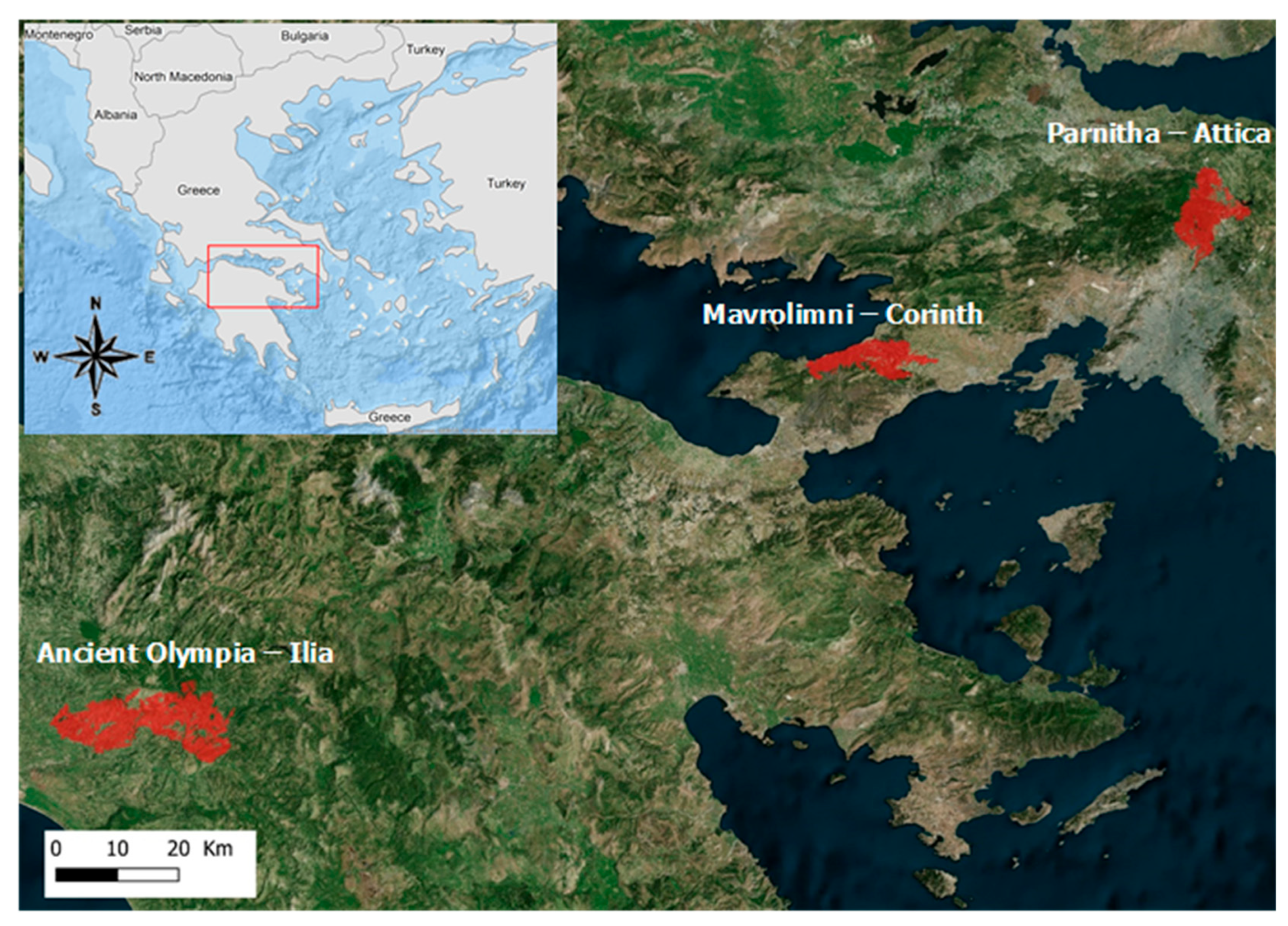


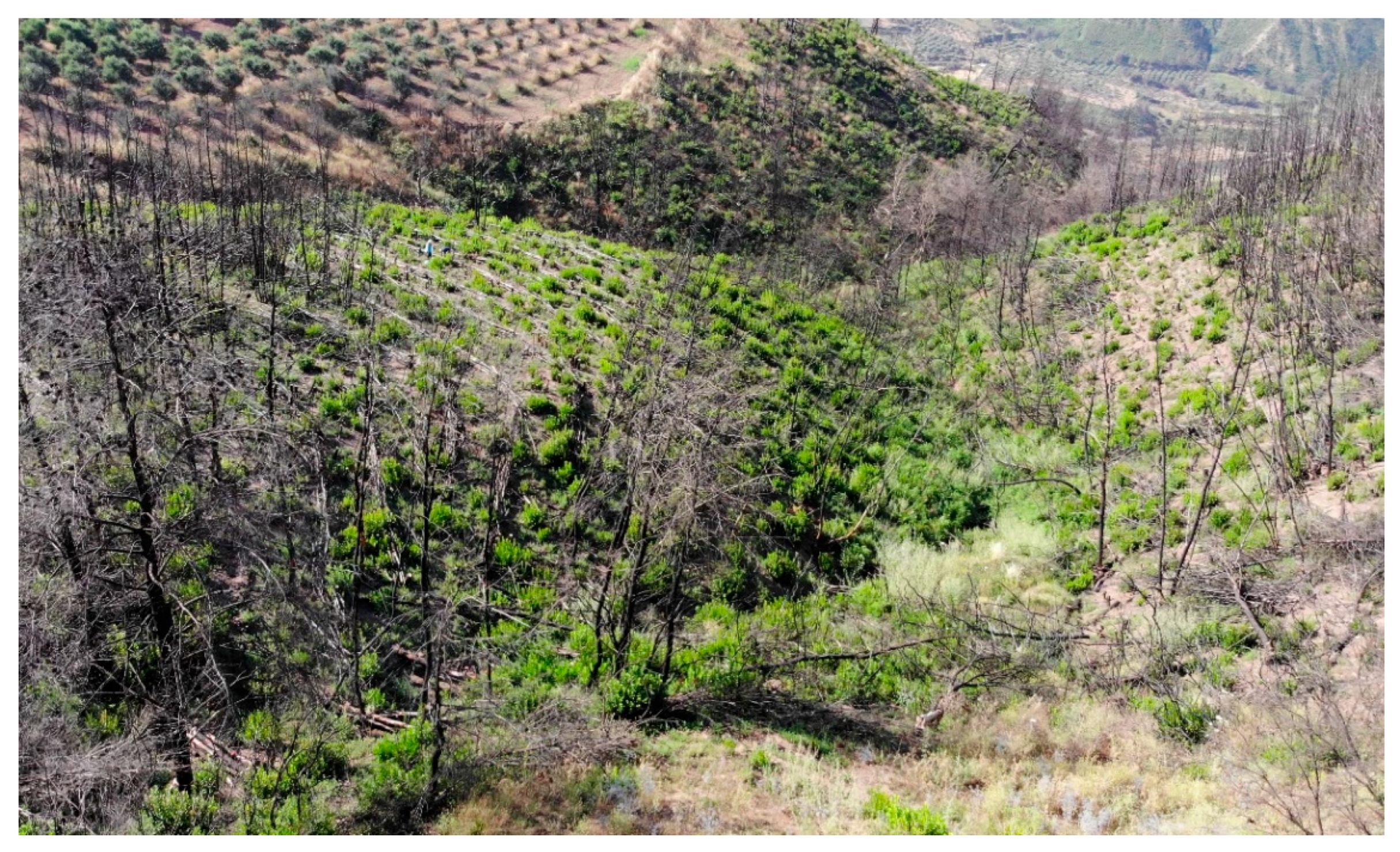

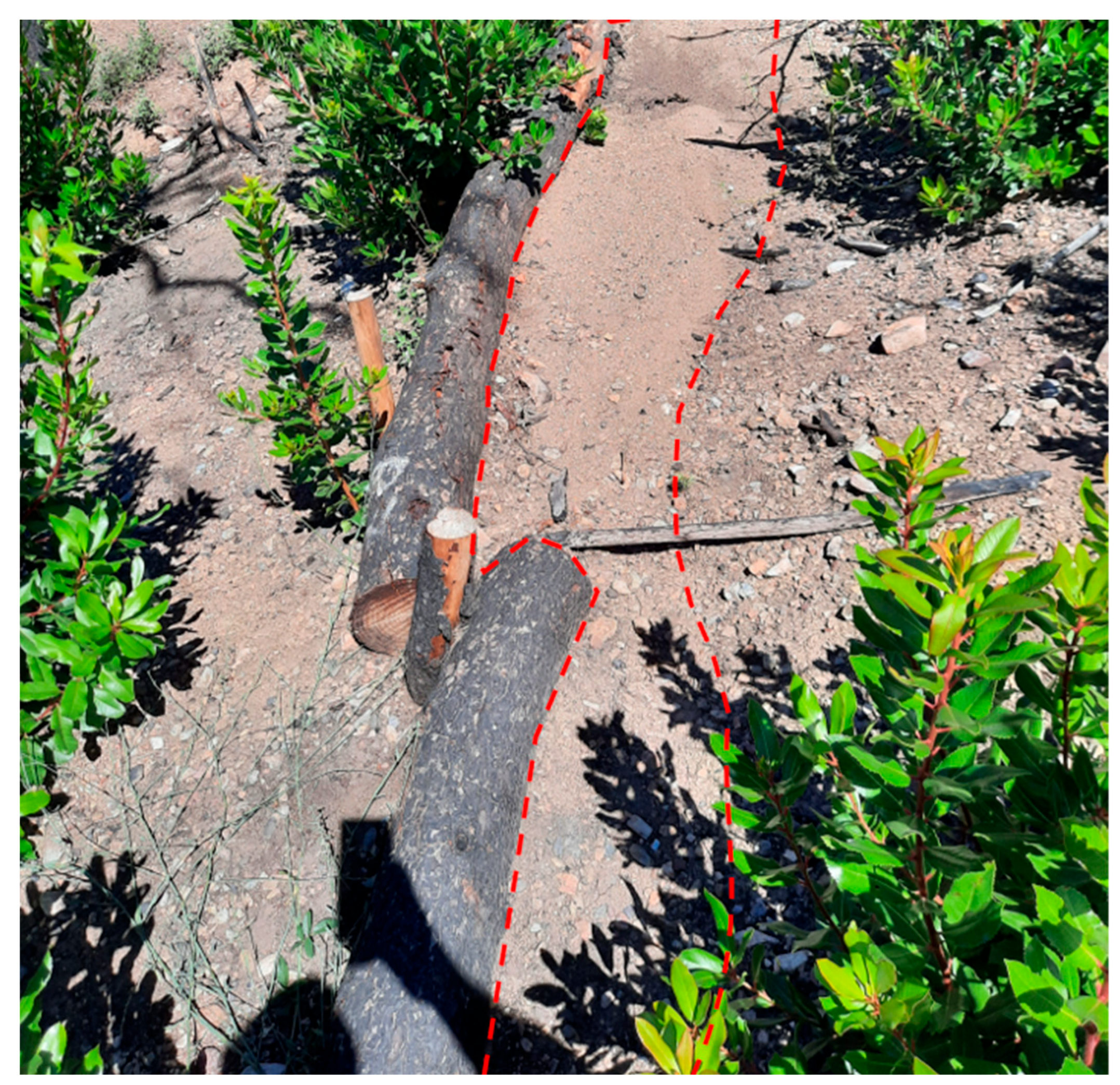


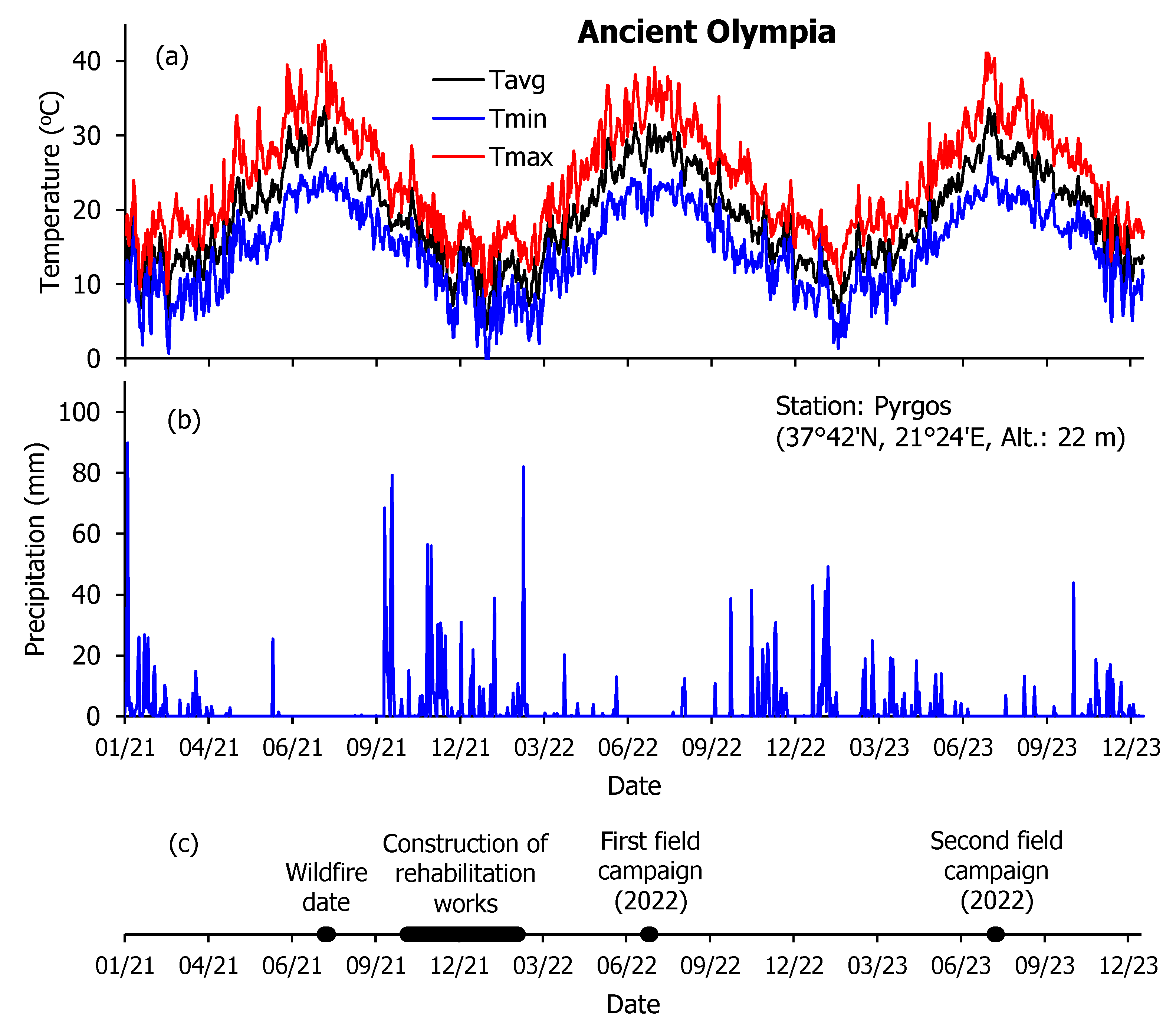
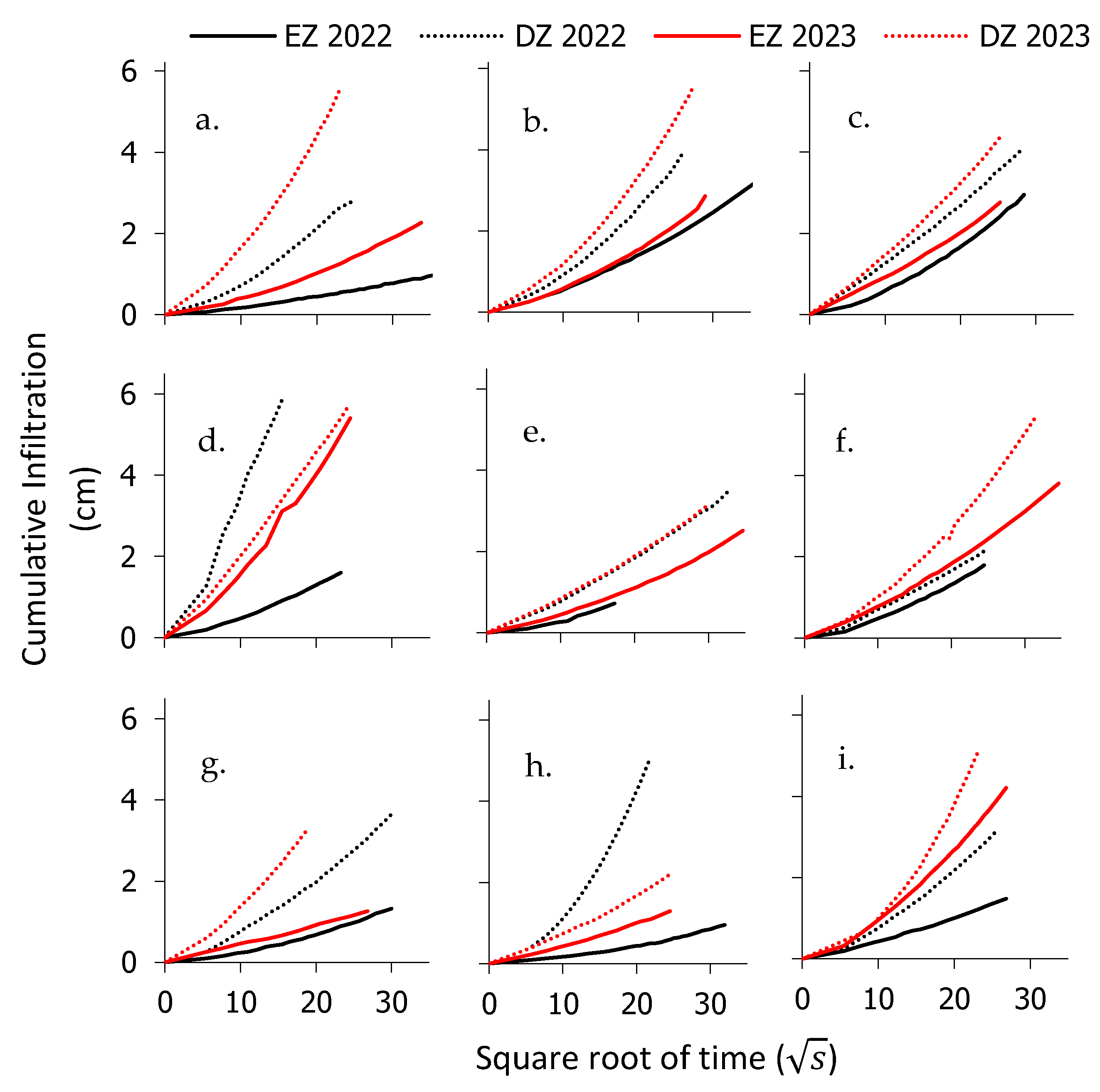
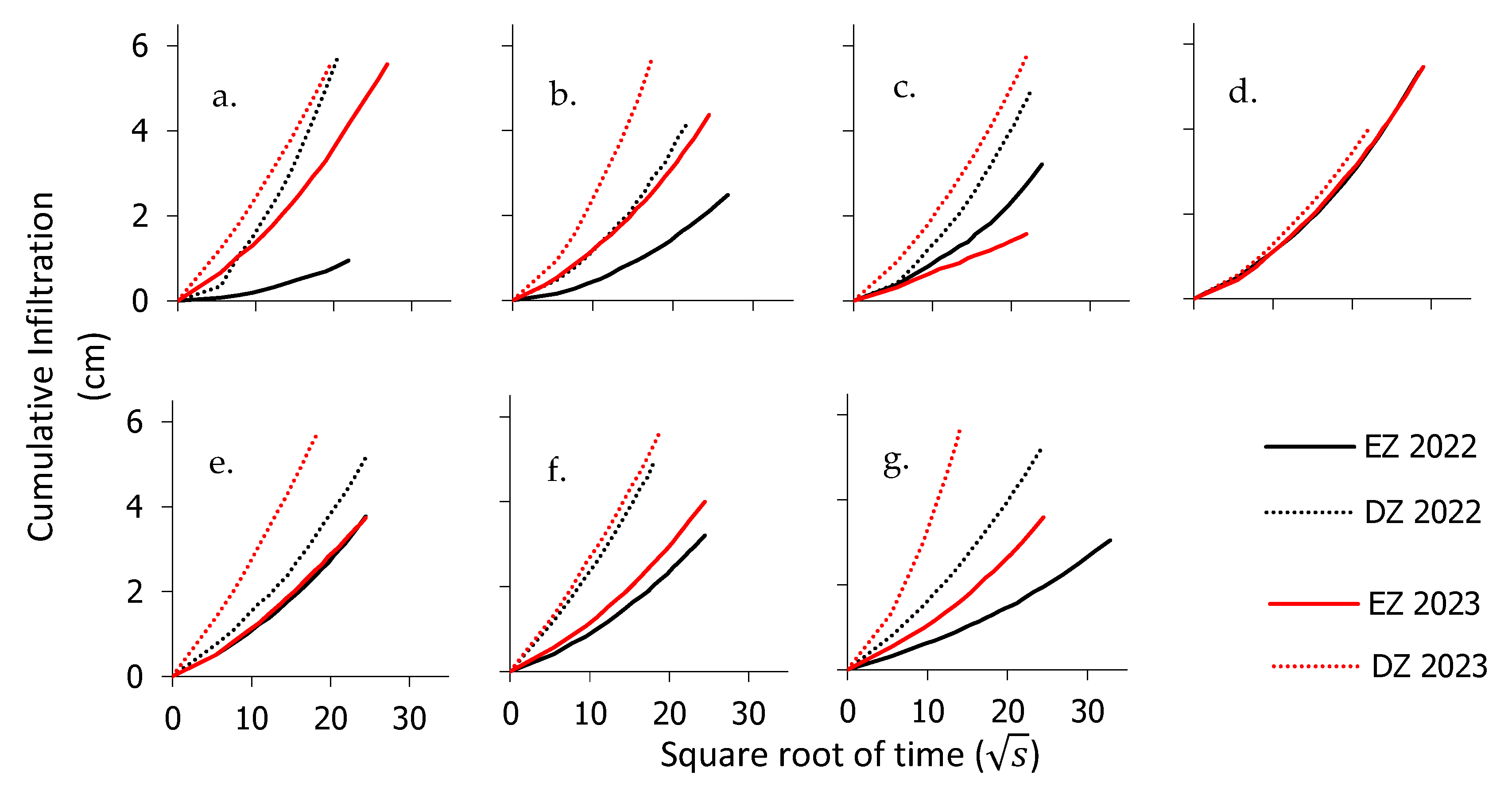

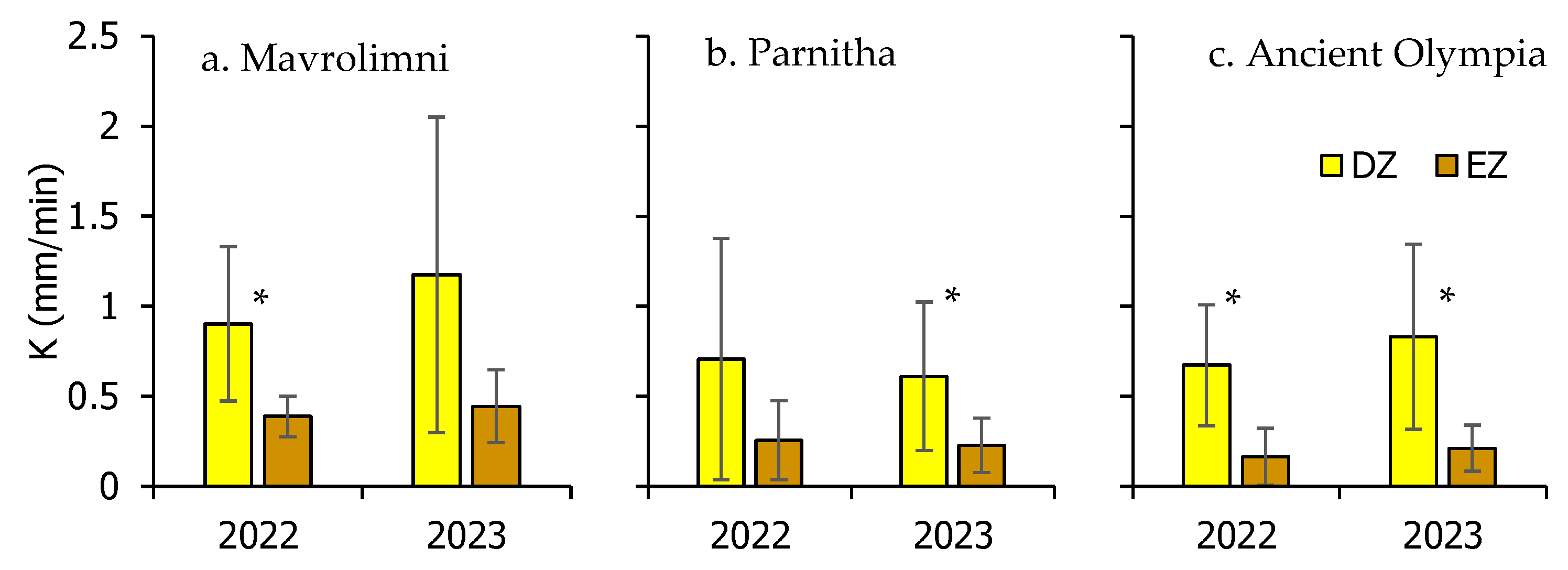
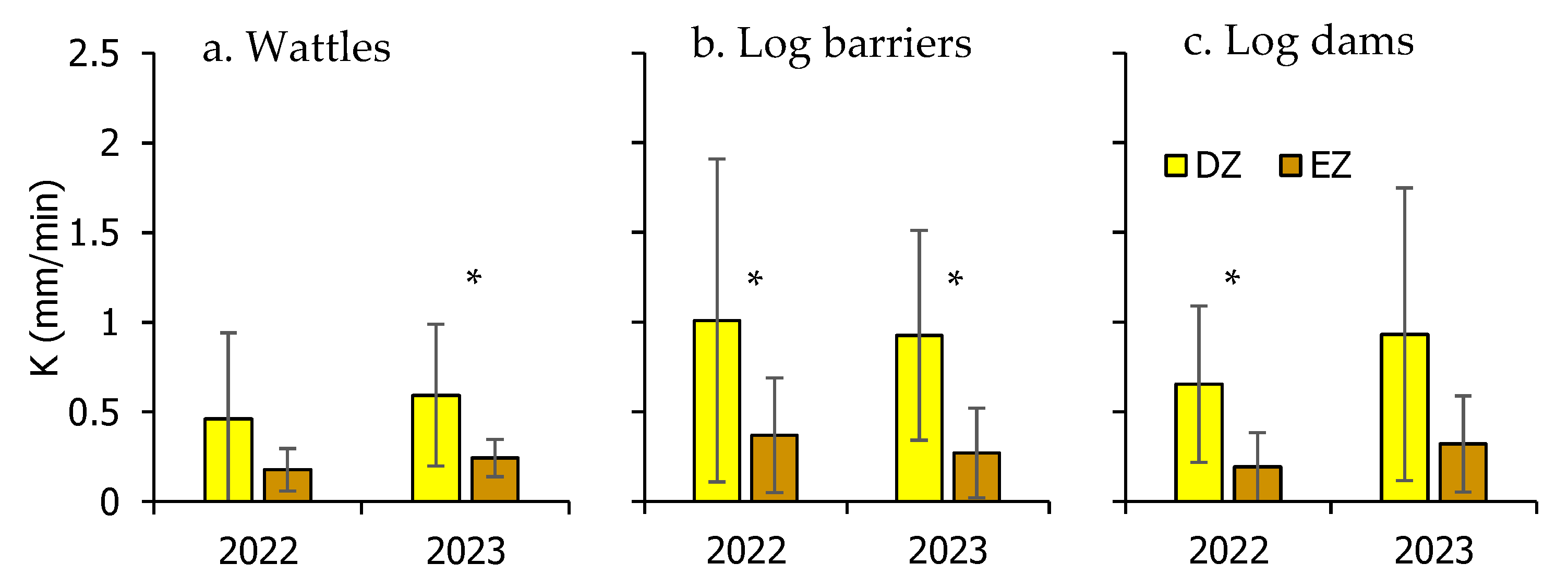
| Site | Plot | Longitude | Latitude | Altitude | Slope | Aspect | Structure Type | Parental Rock | ||
|---|---|---|---|---|---|---|---|---|---|---|
| (deg.) | (min) | (deg.) | (min) | (m) | (deg.) | (deg.) | ||||
| Parnitha | P01 | 23 | 47.610 | 38 | 10.888 | 694 | 13 | 310 | wattle | Schists |
| P02 | 23 | 47.597 | 38 | 10.885 | 688 | 18 | 325 | wattle | Schists | |
| P03 | 23 | 47.546 | 38 | 10.947 | 672 | 19 | 140 | log dam | Schists | |
| P04 | 23 | 47.550 | 38 | 10.937 | 665 | 23 | 150 | log dam | Schists | |
| P05 | 23 | 47.569 | 38 | 10.503 | 621 | 10 | 270 | log barrier | Schists | |
| P06 | 23 | 47.490 | 38 | 10.008 | 605 | 23 | 40 | log barrier | Tertiary deposits | |
| P07 | 23 | 47.450 | 38 | 10.014 | 608 | 29 | 48 | log barrier | Tertiary deposits | |
| P08 | 23 | 47.445 | 38 | 10.024 | 603 | 12 | 110 | log dam | Tertiary deposits | |
| P09 | 23 | 47.574 | 38 | 10.927 | 734 | 29 | 245 | wattle | Schists | |
| Mavrolimni | Μ01 | 23 | 6.013 | 38 | 3.213 | 224 | 28 | 260 | log barrier | Peridotites–gabbros |
| Μ02 | 23 | 6.009 | 38 | 3.220 | 219 | 30 | 290 | log barrier | Peridotites–gabbros | |
| Μ03 | 23 | 6.013 | 38 | 3.222 | 205 | 18 | 280 | log dam | Peridotites–gabbros | |
| M04 | 23 | 6.011 | 38 | 3.237 | 205 | 28 | 270 | log barrier | Peridotites–gabbros | |
| Μ05 | 23 | 6.000 | 38 | 3.236 | 200 | 22 | 330 | log dam | Deposition cones | |
| Μ06 | 23 | 5.993 | 38 | 3.253 | 200 | 17 | 320 | log dam | Deposition cones | |
| Μ07 | 23 | 5.988 | 38 | 3.267 | 216 | 18 | 280 | log barrier | Peridotites–gabbros | |
| Ancient Olympia | AO01 | 21 | 41.471 | 37 | 42.325 | 709 | 38 | 234 | log barrier | Tertiary deposits |
| AO02 | 21 | 41.523 | 37 | 42.303 | 719 | 34 | 253 | log barrier | Tertiary deposits | |
| AO03 | 21 | 41.480 | 37 | 42.321 | 703 | 37 | 195 | log barrier | Tertiary deposits | |
| AO04 | 21 | 41.479 | 37 | 42.294 | 712 | 15 | 200 | wattle | Tertiary deposits | |
| AO05 | 21 | 41.476 | 37 | 42.292 | 712 | 15 | 198 | wattle | Tertiary deposits | |
| AO06 | 21 | 41.477 | 37 | 42.290 | 709 | 13 | 198 | wattle | Tertiary deposits | |
| AO07 | 21 | 41.463 | 37 | 42.322 | 717 | 26 | 190 | log dam | Tertiary deposits | |
| AO08 | 21 | 41.461 | 37 | 42.318 | 720 | 39 | 174 | log dam | Tertiary deposits | |
| AO09 | 21 | 41.471 | 37 | 42.325 | 721 | 25 | 170 | log dam | Tertiary deposits | |
| Study Site | Zone | Soil Type (Number of Samples) | Soil Moisture ± sd (% p.v.) | ||
|---|---|---|---|---|---|
| 2022 | 2023 | 2022 | 2023 | ||
| Parnitha | Deposition Zone (DZ) | Sandy Loam (7) Loam (1) Loamy Sand (1) | Sandy Loam (8) Loam (1) | 11.7 ± 10.1 | 4.1 ± 1.9 |
| Erosion Zone (EZ) | Sandy Loam (7) Sandy Clay Loam (2) | Sandy Loam (7) Loam (1) Loamy Sand (1) | 8.0 ± 7.6 | 5.2 ± 2.7 | |
| Mavrolimni | Deposition Zone (DZ) | Sandy Loam (4) Sandy Clay Loam (3) | Sandy Loam (4) Sandy Clay Loam (2) Loam (1) | 4.6 ± 3.6 | 4.3 ± 0.8 |
| Erosion Zone (EZ) | Sandy Clay Loam (3) Sandy Loam (3) Loam (1) | Sandy Clay Loam (3) Sandy Loam (3) Loamy Sand (1) | 4.2 ± 3.3 | 4.3 ± 2.0 | |
| Ancient Olympia | Deposition Zone (DZ) | Sandy Loam (9) | Sandy Loam (9) | 2.5 ± 3.0 | 1.8 ± 1.2 |
| Erosion Zone (EZ) | Sandy Loam (9) | Sandy Loam (8) Sandy Clay Loam (1) | 0.8 ± 1.0 | 2.1 ± 1.2 | |
| Site |
Soil Particle
Class | Average Percentages % ± sd | |||
|---|---|---|---|---|---|
| Deposition Zone (DZ) | Erosion Zone (EZ) | ||||
| Year 2022 | Year 2023 | Year 2022 | Year 2023 | ||
| Parnitha | Sand | 62.9 ± 9.1 | 63.9 ± 8.2 | 61.2 ± 6.7 | 62.6 ± 10.9 |
| Clay | 13.3 ± 3.0 | 10.9 ± 4.6 | 14.8 ± 5.7 | 12.3 ± 4.4 | |
| Silt | 23.8 ± 7.2 | 25.1 ± 4.1 | 24.1 ± 4.4 | 25.1 ± 8.3 | |
| Mavrolimni | Sand | 60.6 ± 10.9 | 58.8 ± 14.2 | 53.6 ± 8.3 | 58.9 ± 11.4 |
| Clay | 16.1 ± 8.2 | 18.2 ± 11.2 | 22.7 ± 7.2 | 18.5 ± 9.2 | |
| Silt | 23.4 ± 5.4 | 23.0 ± 5.8 | 23.7 ± 3.1 | 22.6 ± 6.7 | |
| Ancient Olympia | Sand | 69.9 ± 4.4 | 71.1 ± 6.9 | 67.9 ± 6.2 | 64.5 ± 3.0 |
| Clay | 11.0 ± 2.0 | 9.6 ± 2.6 | 14.1 ± 1.5 | 14.4 ± 3.7 | |
| Silt | 19.1 ± 3.5 | 19.3 ± 4.8 | 18.0 ± 6.3 | 21.1 ± 2.1 | |
| Site | Vegetation Density (plants/m2) ± sd | |||
|---|---|---|---|---|
| Deposition Zone (DZ) | Erosion Zone (EZ) | |||
| Year 2022 | Year 2023 | Year 2022 | Year 2023 | |
| Parnitha | 20.6 ± 35.7 | 59.3 ± 82.6 | 65.4 ± 100.4 | 41.6 ± 44.0 |
| Mavrolimni | 16.3 ± 15.0 | 29.6 ± 7.6 | 21.9 ± 33.0 | 15.6 ± 13.6 |
| Ancient Olympia | 24.4 ± 45.8 | 57.4 ± 83.5 | 20.7 ± 32.0 | 22.3 ± 28.0 |
Disclaimer/Publisher’s Note: The statements, opinions and data contained in all publications are solely those of the individual author(s) and contributor(s) and not of MDPI and/or the editor(s). MDPI and/or the editor(s) disclaim responsibility for any injury to people or property resulting from any ideas, methods, instructions or products referred to in the content. |
© 2025 by the authors. Licensee MDPI, Basel, Switzerland. This article is an open access article distributed under the terms and conditions of the Creative Commons Attribution (CC BY) license (https://creativecommons.org/licenses/by/4.0/).
Share and Cite
Proutsos, N.D.; Stefanidis, S.P.; Solomou, A.D.; Michopoulos, P.; Bourletsikas, A.; Lattas, P. Impact of Post-Fire Rehabilitation Treatments on Forest Soil Infiltration in Mediterranean Landscapes: A Two-Year Study. Fire 2025, 8, 269. https://doi.org/10.3390/fire8070269
Proutsos ND, Stefanidis SP, Solomou AD, Michopoulos P, Bourletsikas A, Lattas P. Impact of Post-Fire Rehabilitation Treatments on Forest Soil Infiltration in Mediterranean Landscapes: A Two-Year Study. Fire. 2025; 8(7):269. https://doi.org/10.3390/fire8070269
Chicago/Turabian StyleProutsos, Nikolaos D., Stefanos P. Stefanidis, Alexandra D. Solomou, Panagiotis Michopoulos, Athanasios Bourletsikas, and Panagiotis Lattas. 2025. "Impact of Post-Fire Rehabilitation Treatments on Forest Soil Infiltration in Mediterranean Landscapes: A Two-Year Study" Fire 8, no. 7: 269. https://doi.org/10.3390/fire8070269
APA StyleProutsos, N. D., Stefanidis, S. P., Solomou, A. D., Michopoulos, P., Bourletsikas, A., & Lattas, P. (2025). Impact of Post-Fire Rehabilitation Treatments on Forest Soil Infiltration in Mediterranean Landscapes: A Two-Year Study. Fire, 8(7), 269. https://doi.org/10.3390/fire8070269









